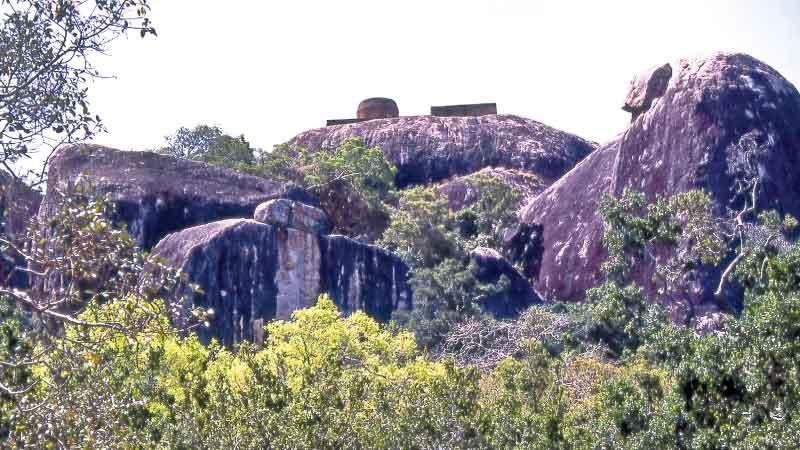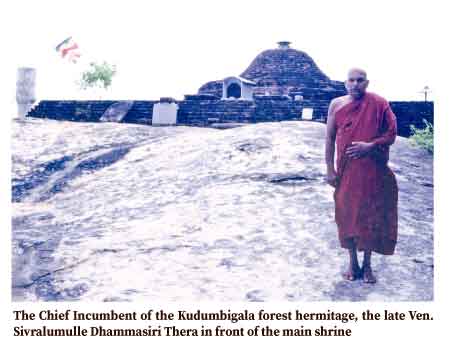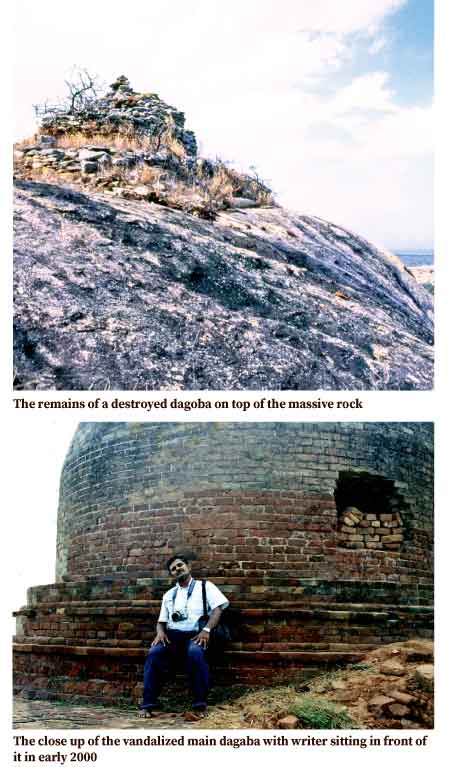
Last Sunday (8), the Government announced travel restrictions on all picnics, pilgrimages and tours to tourist sites around the country for two weeks in view of the deadly COVID-19 outbreak. So, I sat at my computer and pondered what to write about this week.
Thinking of that, I went through one of my old photograph folders, and found a special photograph which I captured two decades ago at the Kudumbigala Forest hermitage during my first visit to the site. The picture I captured was its chief incumbent, the late Ven. Sivralumulle Dhammasiri Thera, dark skinned and well-built, attired in a dark purple colour robe who lived in a cave at the forest hermitage. There was an untold story in that shot, even though 20 years have passed since then. 
Ven. Dhammasiri Thera had been associating with Kudumbigala since 1960 as the Kudumbigala Hamuduruwo, a student of its chief incumbent Ven. Thambugala Anandasiri Thera and after his passing away, Ven. Dhammasiri Thera was in charge of the Kudumbigala hermitage and administrated it.
However, he and his sect of bhikkhus were forced to vacate the hermitage at Kudumbigala during the height of terrorism in the Eastern Province, and moved to the Hulannuge-Tharulengala hermitage, in Hulannuge in Lahugala, bordering a Sinhala village which also faced constant terror attacks.
Ven. Dhammasiri Thera has spent most of his time at Hulannuge in Tharulengala during the LTTE terror in the Eastern Province but never forgot to visit Kudumbigala once a month during the height of the war against terrorism. He walked a distance of around 40 kilometres in the wild animal infested forest from Pottuvil-Panama to Kudumbigala. He had rested and partaken of alms near the bridge at Arugambay in Pottuvil during the walk.
My first visit to the Kudumbigala forest hermitage in Panama in the Eastern Province was in 2000, just after the Peace Accord (MoU) was signed between the Sri Lankan Government and the Liberation Tigers of Tamil Eelam (LTTE) which paved the way for people to visit LTTE controlled areas during the ceasefire period.
The purpose of my three-day journey was to photograph as many archaeological sites as possible in the Ampara district. The numerous ancient Buddhist shrines in the Kumana jungle in the Eastern Province had been abandoned due to terrorism.
The region was a haven for terrorists because of the thick jungle and rock caves of ancient temples which became their hideouts. Although they occupied the caves, artifacts in the caves had not been destroyed by them.
Our journey to Kumana was not as fascinating as we thought. Since the road from Panama to Okanda had just been opened to visitors, it was full of potholes and covered with white sand beyond recognition. The van we travelled in sank in the sand at the Bagura lagoon and being in a group of three, we managed to pull it out.
We abandoned our journey to Kumana at the Bagura lagoon and instead decided to visit Kudumbigala. 
The Kudumbigala forest hermitage is about 40 kilometres west of the Kumana-Panama Wildlife Sanctuary in the Yala East National Park. It dates back to the 3rd Century and was a reputed Buddhist hermitage. The lofty, impressive rock, Kudumbigala is located two kilometres before reaching Okanda from Panama, on the right side. One cannot but take a second look at this bare peak surrounded by the remains of a dagoba. At the base are a number of caves, with rock inscriptions and ruined temple complexes, now occupied by a sect of monastic bhikkhus at the hermitage.
Parking our vehicle at the base of the rock, we climbed the wild-animal infested rocky boulder along a footpath through the forest canopy and reached the summit where the kuti (abode) of the Ven. Dhammasiri Thera was in a spacious cave. The Thera came out from his abode and we greeted him bowing our heads in respect and sat on the floor.
He had returned to Kudumbigala to settle down permanently and was cleaning the surrounding areas with an elderly man. When we climbed the hill, we caught a glimpse of a massive heap of bones of animals beside the footpath in the forest.
The gentle breeze blew across the cave and we were rejuvenated after a hectic climb. The verandah of the cave was full of skeletons of animals from elephants to hare, placed on one side of the verandah. The desk and chair used by the Thera were also made out of the skeleton of an elephant’s head. Sitting on one of the skeletons of an elephant head, he talked to us. I was mesmerised to see these skeletons as it was the one and only place in the country with its interior decorated with skeletons of animals.
Raising my camera, I asked him to pose for a photograph. He said no. “Many people ask me to pose for photos. But I don’t allow them to take my photograph because I don’t like it,” the bhikkhu said. When I pleaded repeatedly, he allowed me to take one snap. I captured his rare picture in front of the main shrine of Kudumbigala. Perhaps, it may be a last photograph of him which I took during my first visit to the ancient site in 2000.
Later, we climbed the adjoining massive rock boulder despite the danger of the gushing wind to the summit where the remains of a few dagobas are located. While one brick-built dagoba stands intact with a big hole dug by treasure hunters, others had been destroyed by the wind and the natural elements.
After the Peace Accord was violated, the terrorists again infiltrated to the East. Ven. Dhammasiri Thera was kidnapped by LTTE terrorists while meditating in his cave in Kudumbigala in 2008. This news spread like wildfire in all media then. He was in the custody of the terrorists for three days in the wild-animal infested jungle with cut injuries. It is said that a sloth bear attacked the terrorists and they ran away.
When the injured bhikkhu returned to the road with bleeding wounds a group of soldiers of the Special Task Force (STF) had spotted him and offered water. While drinking the water, the bhikkhu suffered a coma and was taken to hospital. After recovering he spent a couple of years and passed away at the age of 65, leaving an indelible impression in Kudumbigala.
